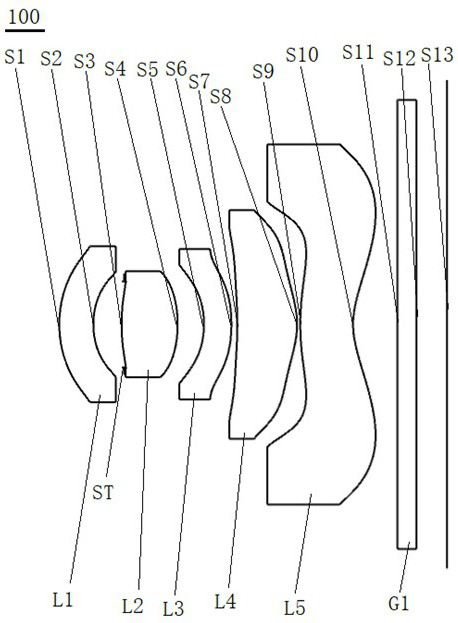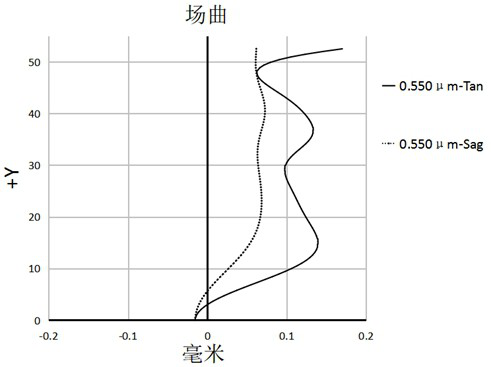Optical lens and imaging device
A technology of optical lens and imaging surface, applied in the field of imaging lens, can solve the problems of optical lens not being able to wide viewing angle, miniaturization and high-quality imaging balance, and achieve the effect of compact structure, good imaging quality, and high-quality imaging balance
- Summary
- Abstract
- Description
- Claims
- Application Information
AI Technical Summary
Problems solved by technology
Method used
Image
Examples
no. 1 example
[0071] see figure 1 , is a schematic structural diagram of the optical lens 100 provided in the first embodiment of the present invention, the optical lens 100 includes in sequence from the object side to the imaging surface along the optical axis: a first lens L1, a stop ST, a second lens L2, and a third lens L3, fourth lens L4, fifth lens L5, filter G1.
[0072] The first lens L1 has negative refractive power, the object side S1 of the first lens is a convex surface, and the image side S2 of the first lens is a concave surface;
[0073] The second lens L2 has positive refractive power, the object side S3 of the second lens is a convex surface, and the image side S4 of the second lens is a convex surface;
[0074] The third lens L3 has negative refractive power, the object side S5 of the third lens is concave, and the image side S6 of the third lens is convex;
[0075] The fourth lens L4 has positive refractive power, the object side S7 of the fourth lens is concave, and th...
no. 2 example
[0090] The structure of the optical lens in this embodiment is roughly the same as that of the optical lens 100 in the first embodiment. The positions of the inflection points on the S8 are: the distance between the inflection point near the optical axis and the optical axis is 0.376mm, and the distance between the inflection point and the optical axis far away from the optical axis is 0.677mm.
[0091] The relevant parameters of each lens in the optical lens provided in this embodiment are shown in Table 3.
[0092] table 3
[0093]
[0094] The surface coefficients of each aspheric surface of the optical lens in this embodiment are shown in Table 4.
[0095] Table 4
[0096]
[0097] Please refer to Image 6 , Figure 7 , Figure 8 with Figure 9 , respectively show the field curvature curve, f-tanθ distortion curve, vertical axis chromatic aberration curve and axial chromatic aberration curve of the optical lens in this embodiment.
[0098] Image 6 Indicates ...
no. 3 example
[0103] The structure of the optical lens in this embodiment is roughly the same as that of the optical lens 100 in the first embodiment, the difference is that the radius of curvature and material selection of each lens are different; and in this embodiment, the image side of the fourth lens The positions of the inflection points on the S8 are: the distance between the inflection point close to the optical axis and the optical axis is 0.395mm, and the distance between the inflection point and the optical axis far away from the optical axis is 0.667mm.
[0104] The relevant parameters of each lens in the optical lens provided in this embodiment are shown in Table 5.
[0105] table 5
[0106]
[0107] Table 6 shows the surface coefficients of each aspheric surface of the optical lens in this embodiment.
[0108] Table 6
[0109]
[0110] Please refer to Figure 10 , Figure 11 , Figure 12 with Figure 13 , respectively show the field curvature curve, f-tanθ distortion...
PUM
 Login to View More
Login to View More Abstract
Description
Claims
Application Information
 Login to View More
Login to View More - Generate Ideas
- Intellectual Property
- Life Sciences
- Materials
- Tech Scout
- Unparalleled Data Quality
- Higher Quality Content
- 60% Fewer Hallucinations
Browse by: Latest US Patents, China's latest patents, Technical Efficacy Thesaurus, Application Domain, Technology Topic, Popular Technical Reports.
© 2025 PatSnap. All rights reserved.Legal|Privacy policy|Modern Slavery Act Transparency Statement|Sitemap|About US| Contact US: help@patsnap.com



